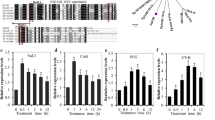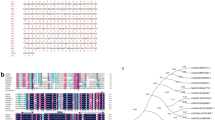Abstract
Chalcone synthase (CHS), a key enzyme in plant flavonoid synthesis, is essential for plant tolerance to abiotic stress. However, little research on CHS from the earliest terrestrial plants, such as mosses, has been reported. Here, the biological function of a CHS gene from Antarctic moss Pohlia nutans (PnCHS1) was studied. PnCHS1 had a 32.8–53.7% similarity to CHS from other species, however it still had highly conserved motifs of CHS such as Catalytic site (Asn366, His333) and Co-A binding site (Ser146). Subcellular localization analysis showed that PnCHS1 was distributed in the cell membrane and in the membranes of endothelial organelles. Heterologous expression of PnCHS1 increased flavonoid content in 5-day-old Arabidopsis grown with 24 h light and 17-day-old Arabidopsis cultured with sucrose, as well as anthocyanin content in the latter. PnCHS1 heterologous expression in Arabidopsis increased plant tolerance to salt stress, including a high germination rate and a long taproot. Heterologous expression of PnCHS1 boosted tolerance to oxidative stress while decreasing the sensitivity to ABA. Under H2O2 or ABA stress, the expression pattern of PnCHS1, ROS scavenging enzyme gene (FeSOD1, FeSOD2, Cu-Zn-SOD2, and Cu-Zn-SOD3) and three genes of ABA signal pathway (RAB18, RD29B, and NCED3) were considerably up-regulated by real-time quantitative analysis. It indicates that PnCHS1 could enhance plant tolerance to NaCl and oxidative stresses, and may play a role in the adaptation of Antarctic moss to extreme environments.








Similar content being viewed by others
References
Bai G, Xie H, Yao H, Li F, Chen X, Zhang Y, Xiao B, Yang J, Li Y, Yang D (2019) Genome-wide identification and characterization of ABA receptor PYL/RCAR gene family reveals evolution and roles in drought stress in Nicotiana tabacum. BMC Genomics 20(1):575
Bao Y, Guo C, Chen S, Liu M (2015) Molecular evolution of chalcone synthase gene superfamily in plants. Chin Bull Bot 50(1):55–71
Bihmidine S, Lin JS, Stone JM, Awada T, Specht JE, Clemente TE (2013) Activity of the Arabidopsis RD29A and RD29B promoter elements in soybean under water stress. Planta 237(1):55–64
Bramley-Alves J, King DH, Robinson SA, Miller RE (2014) Dominating the Antarctic environment: bryophytes in a time of change. In Photosynthesis in bryophytes and early land plants. Springer: Australia, pp 309–324
Busche M, Acatay C, Martens S, Weisshaar B, Stracke R (2021) Functional characterisation of banana (Musa spp.) 2-oxoglutarate-dependent dioxygenases involved in flavonoid biosynthesis. Front Plant Sci 12:701780
Chen LJ, Guo HM, Lin Y, Cheng HM (2015) Chalcone synthase EaCHS1 from Eupatorium adenophorum functions in salt stress tolerance in tobacco. Plant Cell Rep 34(5):885–894
Cuadra P, Guajardo J, Carrasco-Orellana C, Stappung Y, Fajardo V, Herrera R (2020) Differential expression after UV-B radiation and characterization of chalcone synthase from the Patagonian hairgrass Deschampsia antarctica. Phytochemistry 169:112179
Dao TTH, Linthorst HJM, Verpoorte R (2011) Chalcone synthase and its functions in plant resistance. Phytochem Rev 10(3):397–412
Dehghan S, Sadeghi M, Poppel A, Fischer R, Lakes-Harlan R, Kavousi HR, Vilcinskas A, Rahnamaeian M (2014) Differential inductions of phenylalanine ammonia-lyase and chalcone synthase during wounding, salicylic acid treatment, and salinity stress in safflower, Carthamus Tinctorius. Biosci Rep 34(3):273–282
Ferreyra MLF, Serra P, Casati P (2021) Recent advances on the roles of flavonoids as plant protective molecules after UV and high light exposure. Physiol Plant 173(3):736–749
Gambino G, Perrone I, Gribaudo I (2008) A rapid and effective method for RNA extraction from different tissues of grapevine and other woody plants. Phytochem Anal 19(6):520–525
Han Y, Ding T, Su B, Jiang H (2016) Genome-wide identification, characterization and expression analysis of the chalcone synthase family in maize. Int J Mol Sci 17(2):161
Iwashina T (2000) The structure and distribution of the flavonoids in plants. J Plant Res 113(1111):287–299
Jiao C, Gu Z (2019) Cyclic GMP mediates abscisic acid-stimulated isoflavone synthesis in soybean sprouts. Food Chem 275:439–445
Kim BG, Lee ER, Ahn JH (2012) Analysis of flavonoid contents and expression of flavonoid biosynthetic genes in populus Euramericana guinier in response to abiotic Stress. J Korean Soc Appl BI 55(1):141–145
Koduri PKH, Gordon GS, Barker EI, Colpitts CC, Ashton NW, Suh DY (2010) Genome-wide analysis of the chalcone synthase superfamily genes of Physcomitrella patens. Plant Mol Biol 72(3):247–263
Lei KJ, Zhang L, Du XY, An Y, Chang GH, An GY (2018) A chalcone synthase controls the verticillium disease resistance response in both Arabidopsis thaliana and cotton. Eur J Plant Pathol 152(3):769–781
Li CC, Liu SH, Yao XH, Wang J, Wang TL, Zhang ZH, Zhang PY, Chen KS (2017) PnF3H, a flavanone 3-hydroxylase from the Antarctic moss Pohlia nutans, confers tolerance to salt stress and ABA treatment in transgenic Arabidopsis. Plant Growth Regul 83(3):489–500
Li C, Liu S, Zhang W, Chen K, Zhang P (2019) Transcriptional profiling and physiological analysis reveal the critical roles of ROS-scavenging system in the Antarctic moss Pohlia nutans under Ultraviolet-B radiation. Plant Physiol Biochem 134:113–122
Liou G, Chiang YC, Wang Y, Weng JK (2018) Mechanistic basis for the evolution of chalcone synthase catalytic cysteine reactivity in land plants. J Biol Chem 293(48):18601–18612
Liu SH, Wang J, Cong BL, Huang XH, Chen KS, Zhang PY (2014) Characterization and expression analysis of a mitochondrial heat-shock protein 70 gene from the Antarctic moss Pohlia nutans. Polar Biol 37(8):1145–1155
Liu H, Liu S, Wang H, Chen K, Zhang P (2022) The flavonoid 3’-hydroxylase gene from the Antarctic moss Pohlia nutans is involved in regulating oxidative and salt stress tolerance. Biotechnol Appl Biochem 69(2):676–686
Livak KJ, Schmittgen TD (2001) Analysis of relative gene expression data using real-time quantitative PCR and the 2(-Delta Delta C(T)) method. Methods 25(4):402–408
Luo P, Shen Y, Jin S, Huang S, Cheng X, Wang Z, Li P, Zhao J, Bao M, Ning G (2016) Overexpression of Rosa rugosa anthocyanidin reductase enhances tobacco tolerance to abiotic stress through increased ROS scavenging and modulation of ABA signaling. Plant Sci 245:35–49
Mattus-Araya E, Guajardo J, Herrera R, Moya-León MA (2022) ABA speeds up the progress of color in developing F. chiloensis fruit through the activation of PAL, CHS and ANS, key genes of the phenylpropanoid/flavonoid and anthocyanin pathways. Int J Mol Sci 23(7):3854
Narusaka M, Shiraishi T, Iwabuchi M, Narusaka Y (2010) The floral inoculating protocol: a simplified Arabidopsis thaliana transformation method modified from floral dipping. Plant Biotechnol 27(4):349–351
Park HL, Yoo Y, Bhoo SH, Lee TH, Lee SW, Cho MH (2020) Two chalcone synthase isozymes participate redundantly in UV-induced Sakuranetin synthesis in rice. Int J Mol Sci 21(11):3777
Peng LP, Hao Q, Men SQ, Wang XR, Huang WY, Tong NN, Chen M, Liu ZA, Ma XF, Shu QY (2021) Ecotopic over-expression of PoCHS from Paeonia ostii altered the fatty acids composition and content in Arabidopsis thaliana. Physiol Plant 172(1):64–76
Pizarro M, Contreras RA, Kohler H, Zuniga GE (2019) Desiccation tolerance in the Antarctic moss Sanionia uncinata. Biol Res 52(1):46
Pourcel L, Routaboul JM, Cheynier V, Lepiniec L, Debeaujon I (2007) Flavonoid oxidation in plants: from biochemical properties to physiological functions. Trends Plant Sci 12(1):29–36
Qin YX, Liu XZ, Quan XY, Chen JF, Wang ZX (2022) Heterologously expressing a wheat CI Small Heat Shock Protein gene enhances the salinity tolerance of Arabidopsis thaliana. J Plant Growth Regul 41(1):236–243
Robinson SA, Wasley J, Tobin AK (2003) Living on the edge-plants and global change in continental and maritime Antarctica. Global Change Biol 9(12):1681–1717
Santiago IF, Soares MA, Rosa CA, Rosa LH (2015) Lichensphere: a protected natural microhabitat of the non-lichenised fungal communities living in extreme environments of Antarctica. Extremophiles 19(6):1087–1097
Sun F, Yu HQ, Qu JT, Cao Y, Ding L, Feng WQ, Bin Khalid MH, Li WC, Fu FL (2020) Maize ZmBES1/BZR1–5 decreases ABA sensitivity and confers tolerance to Osmotic stress in transgenic Arabidopsis. Int J Mol Sci 21(3):996
Tian L, Wan SB, Pan QH, Zheng YJ, Huang WD (2008) A novel plastid localization of chalcone synthase in developing grape berry. Plant Sci 175(3):431–436
Tong YJ, Lyu YB, Xu S, Zhang L, Zhou JW (2021) Optimum chalcone synthase for flavonoid biosynthesis in microorganisms. Crit Rev Biotechnol 41(8):1194–1208
Vadivel AKA, Krysiak K, Tian G, Dhaubhadel S (2018) Genome-wide identification and localization of chalcone synthase family in soybean (Glycine max [L]Merr). BMC Plant Biol 18(1):325
van Zelm E, Zhang Y, Testerink C (2020) Salt tolerance mechanisms of plants. Annu Rev Plant Biol 71:403–433
Wang J, Li C, Yao X, Liu S, Zhang P, Chen K (2017) The Antarctic moss leucine-rich repeat receptor-like kinase (PnLRR-RLK2) functions in salinity and drought stress adaptation. Polar Biol 41(2):353–364
Wang Z, Yu Q, Shen W, El Mohtar CA, Zhao X, Gmitter FG (2018) Functional study of CHS gene family members in citrus revealed a novel CHS gene affecting the production of flavonoids. BMC Plant Biol 18(1):189
Wang H, Liu H, Yu Q, Fan F, Liu S, Feng G, Zhang P (2021a) A CPD photolyase gene PnPHR1 from Antarctic moss Pohlia nutans is involved in the resistance to UV-B radiation and salinity stress. Plant Physiol Biochem 167:235–244
Wang Y, Liu Q, Liu Y, Li G, Xia G, Wang M (2021b) Ectopic expression of a wheat superoxide dismutase gene TaSOD5 enhances salt and oxidative stress tolerance in Arabidopsis. Biol Plant 65:19–26
Wang J, Wang X, Zhao S, Xi X, Feng J, Han R (2022) Brachypodium BdCHS is a homolog of Arabidopsis AtCHS involved in the synthesis of flavonoids and lateral root development. Protoplasma. https://doi.org/10.1007/s00709-022-01819-1
Waterman MJ, Bramley-Alves J, Miller RE, Keller PA, Robinson SA (2018) Photoprotection enhanced by red cell wall pigments in three East Antarctic mosses. Biol Res 51(1):49
Xu ZH, Mahmood K, Rothstein SJ (2017) ROS induces anthocyanin production via late biosynthetic genes and anthocyanin deficiency confers the hypersensitivity to ROS-Generating stresses in Arabidopsis. Plant Cell Physiol 58(8):1364–1377
Yamazaki Y, Suh DY, Sitthithaworn W, Ishiguro K, Kobayashi Y, Shibuya M, Ebizuka Y, Sankawa U (2001) Diverse chalcone synthase superfamily enzymes from the most primitive vascular plant. Psilotum Nudum Planta 214(1):75–84
Yao XH, Wang TL, Wang HJ, Liu HW, Liu SH, Zhao QG, Chen KS, Zhang PY (2019) Identification, characterization and expression analysis of the chalcone synthase family in the Antarctic moss Pohlia nutans. Antarct Sci 31(1):23–33
Yu HN, Wang L, Sun B, Gao S, Cheng AX, Lou HX (2015) Functional characterization of a chalcone synthase from the liverwort Plagiochasma appendiculatum. Plant Cell Rep 34(2):233–245
Zhang X, Abrahan C, Colquhoun TA, Liu CJ (2017) A proteolytic regulator controlling chalcone synthase stability and flavonoid biosynthesis in Arabidopsis. Plant Cell 29(5):1157–1174
Zhang XY, Wei JY, Tian JY, Li N, Jia L, Shen WB, Cui J (2019) Enhanced anthocyanin accumulation of immature radish microgreens by hydrogen-rich water under short wavelength light. Sci Hortic 247:75–85
Funding
This work was supported by the Natural Science Foundation of Shandong Province (ZR2022MC075) and the National Natural Science Foundation of China (41976225).
Author information
Authors and Affiliations
Corresponding author
Ethics declarations
Conflict of interest
The authors declare no conflict of interest.
Additional information
Publisher's Note
Springer Nature remains neutral with regard to jurisdictional claims in published maps and institutional affiliations.
Supplementary Information
Below is the link to the electronic supplementary material.
Rights and permissions
Springer Nature or its licensor (e.g. a society or other partner) holds exclusive rights to this article under a publishing agreement with the author(s) or other rightsholder(s); author self-archiving of the accepted manuscript version of this article is solely governed by the terms of such publishing agreement and applicable law.
About this article
Cite this article
Li, C., Xu, X., Liu, S. et al. PnCHS1, a chalcone synthase from the Antarctic moss Pohlia nutans, improves the tolerance of salt stress and ABA. Plant Biotechnol Rep 18, 105–117 (2024). https://doi.org/10.1007/s11816-023-00873-2
Received:
Revised:
Accepted:
Published:
Issue Date:
DOI: https://doi.org/10.1007/s11816-023-00873-2




